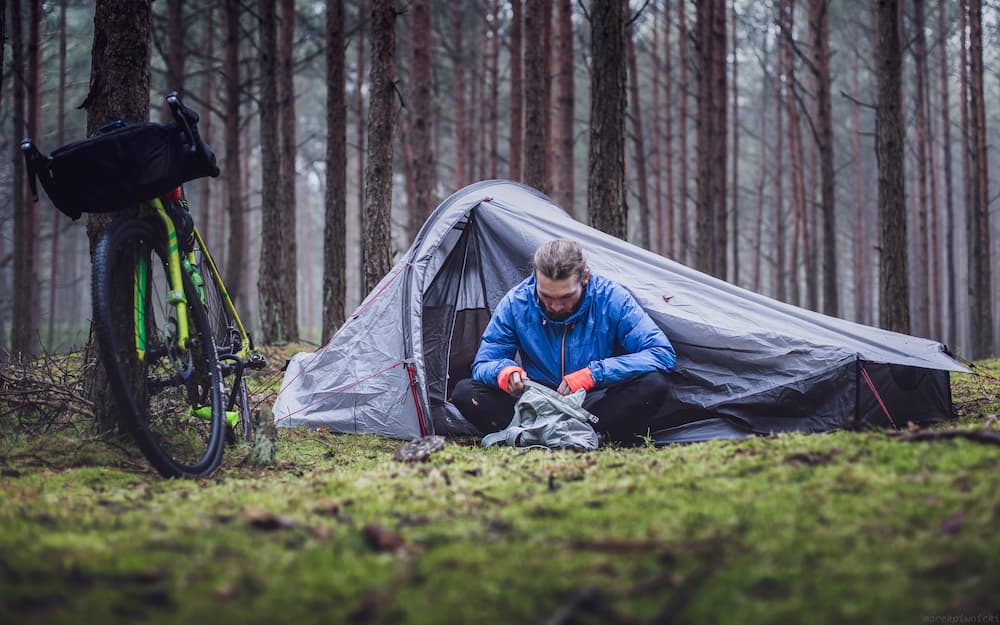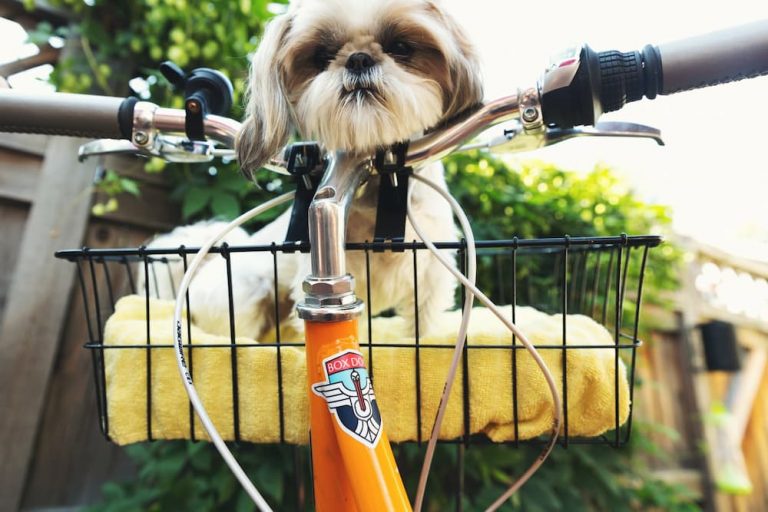How To Carry A Tent On A Bike When Bikepacking?
If you are touring off the beaten path and all set to camp up in the wilderness, you are assured to need a tent.
No matter how compact and lightweight your tent may be, there’s always a fix on how to carry a tent on a bike.
Let’s face it. Tents are bulky, even when they are wrapped up in their enclosed cylindrical stamps. The poles needed to set the tent up might be another headache even if you have a tent that folds down to a backpack.
Contents
How to Carry a Tent on a Bicycle?

Depending on what kind of bikepacker you are and what type of trip you’ve pedaled out on, you can choose a suitable method to carry your camping gear while riding a bike.
Whether you allow a little burden on your ride, or you are a hiker looking to reduce the weight on your bicycle as much as possible, the following ways are ideas to carry your tent safely and simply.
Get a Handlebar Dry Bag or/and Harness
Handlebar bags, dry bags, and a handlebar harness are one of the more popular ways among touring cyclists when it comes to bearing a tent on a bicycle. You can use the individual bags, only the harness, or a combination of the two.
The trendy plea is a handlebar harness that comprises dual alterable straps to be mounted on the handlebar itself or a drop bar, as most harnesses are compatible with. Another strap is wrapped around from the front to stabilize the setting. These harness bags are ideal and budget-friendly for a tent that packs up to a cylindrical shape.
You might prefer a handlebar harness that comes with a rubber spacer to allow a gap between the bar and the cables. If your harness does not come with one, you can always use an additional extender to create the gap.
Drybags are a perfect fit with handlebar harnesses as they roll up to a cylinder and hardly add any bulk to the handlebar.
You may want to ditch the harness if that’s extra bills for you. In that case, a conventional handlebar bag is easy to use, accessible, and a spacious solution. With head tubes and adjustable tubes, handbag bags fit into your handlebar without hassle.
When using the handlebar to strap in a harness or a bag, you’ll have to be careful about carrying a lightweight tent on a flat bar. Road bike handlebars might not be the best to be burdened with anything upfront.
Strap It on the Handlebars
If you are not one to invest in yet another bicycle accessory like a handlebar harness and you’re sure to keep your pannier free of burden, you might still be able to use your handlebar to transport your tent on a bicycle.
This is one of the easiest, tool-free ways of getting the job done. It’s exactly liked the harness mechanism, except you make the same arrangement without a fancy kit. For this, all you have to do is hold the tent against the bar and use two, or three straps to wrap around the handlebar.
For the straps, you can use reflective rubber, or nylon buckles that are adjustable in size and sturdy build. Bungee or two straps can also be used if you ensure a tight and secure fit.
The shortcoming to having to strap your tent to the handlebar comes into play when you have a road style handlebar. Mountain bike handlebars with straight style have longer bars and can drape most tent poles but if your tent is such that it would add too much height to the handlebar, you’d want to leave the handlebar alone.
Whether it is a handlebar harness, bags, or straps, you’ll be able to carry up to a 2-person tent to ensure the center of gravity and stability of your bicycle is not disrupted. Additionally, you wouldn’t want to damage your handlebar by adding to much weight. Also, you’ll have to keep your sleeping bag tucked away in a bag pack or saddlebag.
Carry It on Rear Rack
Your rear bike rack is possibly the first part of your bicycle that comes to your, and our minds when you think of hauling absolutely anything on the bicycle and carrying it along.
For long-distance, night-long camping trips when you need just more than just a sleeping bag and tent to go with, you’d want to use your pannier rack for that extra storage space.
If you already don’t own a rear rack with your bicycle, it’s vital to invest in one that is made of an unyielding, durable material like stainless steel or aluminum. Pannier bags are specifically designed and mounted on pannier racks, where you complete your bikepacking with all additional gears including the tent.
While taking your tent inside your pannier protects the gear from rain and show, you would also have to keep in mind that your chances of bringing in more gears cuts significantly for the forewent rear space.
Get a Tent that Can Be Dismantled
For heavier or longer tents, with a flat or drop bar, it wouldn’t be wise to burden your handlebar or your rear rack, particularly if you have sleeping bags and other gears to haul up on your bicycle.
One way to carry your tent on a bicycle would include segregating the parts of the tent and take them into each bag compartment or bike section. Carrying a tent is already challenging, and with all the parts, you’d still need enough space around the bike and in your bags to carry the parts.
You’ll have the tent’s mesh entryway, detachable rainfly, base, and the notorious poles to carry. While you can fold down the fabrics and store them comfortably, the poles might need a frame bag.
Another way to carry the poles is to affix them to the bike’s top or bottom tube, making sure there is enough pedaling clearance. You can use Velcro strapping tapes or bungee cords to attach the poles to the frame of the bicycle.
When you dismantle the tent parts, you will not have to worry about adding unsafe loading on your handlebar and damaging it. There is hardly any clearance issues if you strap the poles right, and your rear rack does not tilt from any unbalanced, extra weight.
Secure It Outside the Handlebar Bag
You might think there are no other means to carry your tent with the support of your handbag but a handlebar bag can work equally well as a carrier of your tent.
Contrary to other handlebar options, you can carry another bag on the front along with the tent in this case. A more dependable way to use bags to support a strap is using drop bars for the support.
When opposed to a flat bar, a drop bar is slightly more expensive. Because they are narrower, these bars don’t have much control in making turns. However, for strapping a double capacity bag, a drop bar is more reliable for the space it offers.
Use the additional Velcro straps on your handlebar bag or the D loop on your saddle bag to fasten the tent to the bag. It is discreet to only use this method if both the bags tied up front are considerably lightweight.
You may also have to keep in mind that a double bag on your handlebar might mean more obstruction on your front pedals and wheel. For shorter distances, and light cycling and camping, a doubling up on the handle might be another simple way to carry your tent.
Look for Tent Alternatives
Don’t carry the tent at all. That’s probably not what you expect to read here but better alternatives to a tent are on the rise and cyclists are all in for it. After all, bikepacking is time and effort invested.
Although there cannot be many options if you are camping out on longspun winter nights and need to sleep in, summer camping is doable with a sleeping bag and r value pad.
Other than that, Bivy bags are one of the alternatives to a tent that are less bulky but offer smaller space as well. Bivy sacks are weather proof and only take minutes to snap into place. You can also opt for the trendy tarp shelters that have been quite a rage in the world of bike packers, primarily due to their lightweight build.
Final Thoughts
When heading out for long adventures, your bike-packing skills come in handy. The better you pack it all up, the more comfortable your ride gets.
Carrying a tent on a bike while you take on the rough and sloppy grounds might be challenging if you don’t do it the right way. Knowing where to put the tent when bikepacking helps you pack all the other gears better as well.






